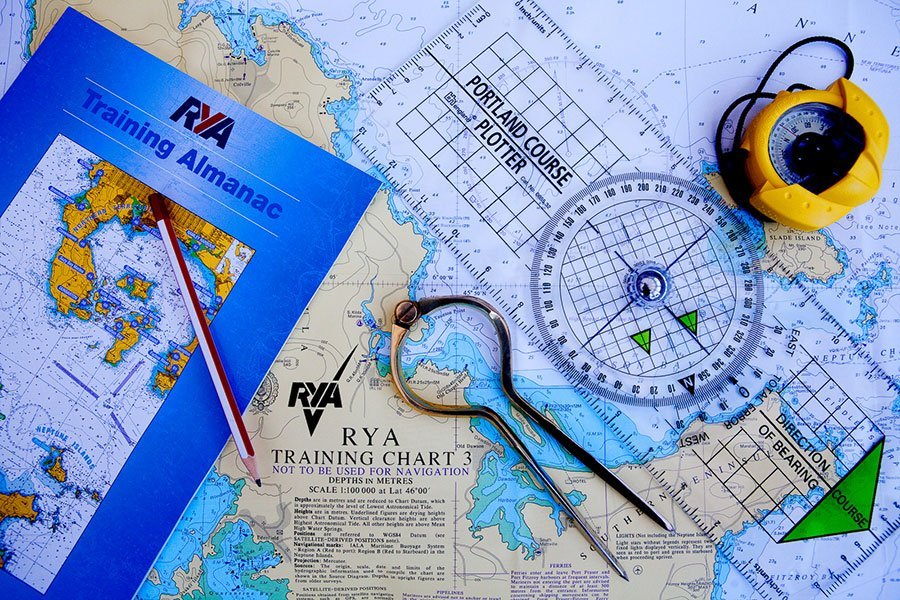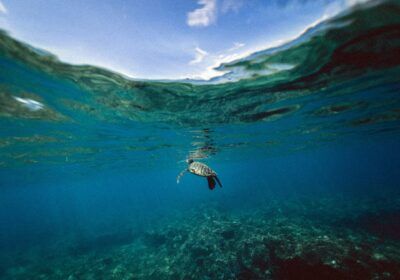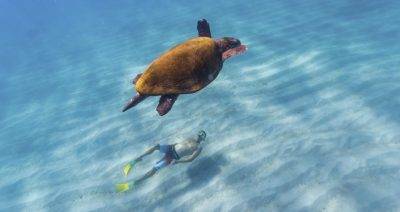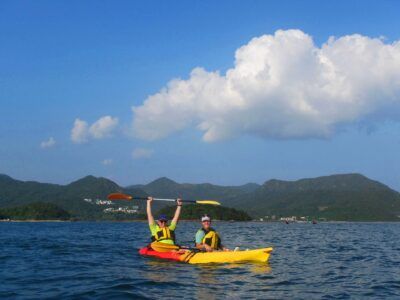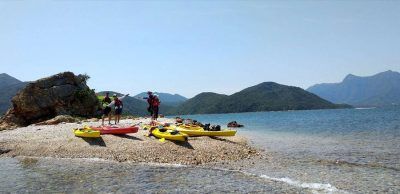A guide to kayak & nautical terms. What is it and why is it important?
The letter A
Abaft | Behind, toward a vessel’s stern. |
Abeam | Off the side, amidships, at right angles to the fore and aft line. |
Adrift | Not made fast, floating loose, at mercy of wind and current. |
Aft | A directional term indicating the rearward or back area of the vessel. Opposite of fore. |
Aground | Touching or stuck on the bottom. |
Ahead | In front of the vessel, forward; opposite of astern. |
Aloft | Above deck, usually in the rigging. |
Amidships | In or toward a vessel’s middle part, between the sides or between bow and stern. |
Anchor | Device used to secure vessel to bottom of body of water. |
Astern | At any point behind the vessel, backward. |
Athwartship | At right angles to the fore-and-aft line of a vessel. |
Aweigh | The position of anchor as it is raised clear of the bottom. |
B
Back | Change in direction of the wind in counterclockwise direction, opposite of veer. |
Ballast | Extra weight carried low in a vessel to increase stability. |
Batten Down | Secure hatches and loose objects both within the hull and on deck. |
Beacon | A marked post located on a shoal or bank to warn vessels of danger or to mark a channel. A signal mark on land; a light or radio signal. |
Beam | 1. The widest part of the vessel. For example a typical beam of a kayak is 22 to 24 inches. 2. A horizontal athwartship support for the deck. |
Bear Off | Steer away from the wind, shore or any object. |
Bearing | The angular direction in which an object is observed with respect to a reference direction or another object , usually yourself |
Belay | 1. Secure a line without a knot or hitch. 2. Command to stop or cease action, as in “Belay that, sailor!” |
Below | Beneath the deck. |
Bend | 1. Secure a sail fast to a spar or stay. 2. Knot to secure a line to another line or object such as an anchor. |
Bight | Open or closed loop in a line or rope. |
Bilge | The lowest part of the vessel’s interior. |
Bollard | Stout post on wharf or pier for securing mooring lines. |
Boot Top | A painted line that indicates the designed waterline. |
Buoyant | An object is positively buoyant when the density of the object is less than that of the fluid it is in. Positively buoyant objects float, negatively buoyant objects sink. |
Bow | The sharper end that usually goes first. |
Broach | The turning of a vessel broadside to the wind or waves, subjecting it to possible capsizing. |
Bulkhead | A vertical partition or wall. |
Bulwark | Extension of topsides above deck. Kayaks don’t have any. |
Buoy | An anchored float used for marking a position on the water or a hazard or a shoal and for mooring |
C
Capsize | To turn over, upset. |
Cast Off | To let go a line, as to cast off a bow line. |
Center of Buoyancy | In mechanical physics, this is the averaged spatial location of the force of buoyancy acting upon a object. |
Center of Gravity | In mechanical physics, this is the averaged spatial location of the force of gravity acting upon a object. For objects small compared to the variation in the gravity field, this is at same location as the center of mass. |
Center of Mass | In mechanical physics, this is the averaged spatial location of the mass of the object. The motions of the entire body can be described by the motions of this point trough space and the rotation of the body around this point. |
Chine | The chine is an angle on the bottom of the vessel where the flair decreases as the hull transitions from the bottom of the vessel to the sides.. A hard chine is where that angle decreases rapidly making a sharp angle. A hard chine kayak has a well defined turn where the “V” comes up to the side. This hard chine gives a unique feel to a kayak giving very good stability even in a narrow craft. Below is a schematic of a hard chine. Round hull vessels have no chine.
|
Chock | 1. A heavy fitting of metal or wood with two jaws curving inward, through which a rope or cable may be run. 2. A block or wedge placed under something else to keep it from moving 3. To fit with or secure by a chock |
Cleat | A fitting, secured to the deck, mast, or spar, having two projection horns to which lines are made fast. |
Cleopatra’s Needle | Position of the kayak when one end fills with water and the other end sticks up in the air. Kayak is rendered useless. z |
Coaming | The raised edge around the cockpit. Its primary purpose is to divert water from entry into the cockpit area. In touring and whitewater vessels, a fabric skirt is placed around the coaming to keep water from entering the cockpit when the edge of the cockpit is below the water. |
Cockpit | Well or sunken space in the deck. A semi-enclosed area where the paddler sits. |
Compass Error | Combined effect of variation and deviation. |
Course | Intended direction for a vessel to travel. |
Course Made Good | Actual vessel track or course after adjusting for such factors as current and leeway. |
Cross Section | The cross section is the shape of the kayak from one side to the other, perpendicular to its center line. A round hull is extremely fast but very unstable where a flat hull is initially stable but very slow. Flared sides give comfortable secondary stability because of added buoyancy when leaning to the side. A “V” bottom vessel has a defined angle at the keel.
|
D E
Deck | Horizontal covering resting on the deck beams of a vessel, the floor of any compartment. |
Density | The mass of an object divided by its volume. |
Deviation | Differences between the compass reading and an actual magnetic direction caused by magnetic forces in the vicinity of the compass, which are usually the result of masses of metal, speaker magnets, etc |
Displacement Hull | A type of hull that plows through the water, displacing a weight of water equal to its own weight, even when more power is added |
Draft | The depth a vessel sinks when afloat, as measured vertically from the water line to the lowest point. The vessel needs this much water depth or it will be aground. |
Drogue | Object streamed from vessel to decrease speed. |
Ebb | A receding current. |
F
Fair-lead | Fitting to route control lines or cables. |
Fish Form | Describes a hull form where the beam (widest portion) of the hull is in the front half of the vessel, often in front of the paddler. Its opposite is the swede form. |
Flare | Flare is the angle that a vessel gets wider as it gets higher. Flared sides give comfortable secondary stability because of added buoyancy when leaning to the side. Here is a vessel designed with moderate flair in both the bow
and stern. (CLC Pax 20) Here is a vessel with extreme (or strong) flair in both the bow
and stern. (CLC Pax 18) |
Flood | A incoming current. |
Following Sea | An overtaking sea that comes from astern. |
Fore | A directional term indicating the forward or front area of the vessel. Opposite of aft. |
Freeboard | The distance between the waterline and the lowest point of the deck of the vessel |
G
Give-Way Vessel | That vessel which, according to the applicable Navigation Rules, must give way to the stand-on vessel. Superseded the term burdened vessel. |
Ground Tackle | An anchor and anchoring gear. |
Gunwale | Pronounced “Gun’l”. The top outside edge of an open vessel such as a canoe or row boat. Where hull and deck meet for vessels with a deck. |
H
Hatch | An opening in a boat’s deck fitted with a watertight cover. |
Head | 1. A vessel’s toilet. 2. The upper corner of a triangular sail. 3. The foremost part of a vessel. |
Heading | Direction in which a vessel is pointing at a given moment. |
Headway | Forward movement or the rate of forward movement |
Heave | 1. To throw, as to heave a line ashore. 2. The rise and fall of a vessel in a seaway. |
Heave To | To bring a vessel to a position where she will maintain little or no headway, usually with the bow into the wind or nearly so. |
Heel | The leaning of a vessel to one side such as caused by the wind. |
Hitch | A knot used to secure a rope to another object or to another rope, or to form a loop or a noose in a rope |
Hull | The main body of a vessel exclusive of spars and rigging. |
I J K
Inboard | 1. More toward the center of a vessel; inside. Opposite of outboard. 2. A motor fitted inside a boat. Opposite of outboard |
Jetty | A structure, usually masonry, projecting out from the shore; a jetty may protect a harbor entrance |
Keel | A ridge or projection on the very bottom of the vessel. The keel may be very indistinct in a narrow “V” bottomed vessel or nonexistent on a flat bottomed vessel. |
Knot | 1. A nautical mile-per-hour measure of speed. A nautical mile is approximately 6076 feed. (A stature mile is 5280 feet.) 2. A means of joining two lines together or fastening a line to an object. |
L M N
Latitude | Parallel lines indicating the number of degrees in the angle between the Earth’s axis of rotation and a line perpendicular to that axis. (The equator) The equator is 0 degrees. The North and South poles (rotational axes) are 90 degrees North and 90 degrees south respectively. The distance between lines of latitude are constant. Lines of latitude are easily determined from measuring the angle of the sun and knowing the date. |
Lee | A calm area behind a solid object that blocks the wind. |
Lee Shore | Shore which offers protection from the wind or current. Opposite of windward shore. |
Leeward | Direction away from the wind: Downwind. pronounce loo-rd |
Lie To | 1. See heave to 2. Behavior of a vessel when anchored e.g. lie to anchor |
List | The leaning of a vessel to one side caused by misplaced or shifting ballast or a leak. |
Longitude | Great circle lines measuring the angle between the zero meridian, designated as running directly north-south through the Royal Observatory in Greenwich England from 0 degrees to 180 degrees either east of west of the zero meridian. The distance between lines of longitude are not constant. Longitude is easily determined by measuring the time of the sun’s zenith. Knowing the time accurately was a big problem for earlier navigators. |
Lubber’s Line | A mark or permanent line on a compass indicating the direction forward parallel to the keel when properly installed. |
Mooring | An arrangement for securing a boat to a mooring buoy or a pier. |
Midship | Approximately in the location equally distant from the bow and stern |
Nautical Mile | Unit of distance equal to 6076.1 feet. Original intended to be 1/24000 of the circumference of the earth at the equator. |
O P Q
Outboard | 1. Toward or beyond the boat’s sides. Opposite of inboard. 2. A detachable engine mounted on a boat’s stern. Opposite of inboard. |
Overboard | Over the side or out of the boat. |
Painter | A line tied to the bow of a dinghy for towing or making fast. |
Pier | A loading platform extending out from the shore. |
Pitchpole | Capsize end over end. Not fun when unintentional. |
Piling | Support, protection for wharves, piers etc |
Plan View | The shape of the vessel looking straight down from the top. From this view you can easily see the widest part of the vessel. This is usually at deck level near the cockpit. A swede form kayak has a cleaner, longer slender entry giving easy touring speed and maneuverability. A fish form kayak may have a slightly blunter entry but will have a more slender exit through the water which increases tracking, even in adverse conditions. The actual performance of the kayak will be determined by the waterline shape, not the deck shape. |
Planing Hull | A type of hull shaped to glide easily across the water at high speed |
Port | 1. The left side of a vessel, looking forward. Opposite of starboard. 2. A place in which a vessel can find shelter. 3. An opening in the side of a vessel. |
Quarter | After part of a vessel’s side (port quarter, starboard quarter). |
R
Relative Bearing | Direction of an object relative to a vessel’s heading. |
Rocker | The curve on the bottom of the vessel along the center line from the bow to the stern. Think of the bottom of a rocking chair. The more rocker the easier the vessel will turn. The less rocker the harder it is to keep the vessel going straight. A whitewater vessel usually has a lot of rocker because quick turns are important. A touring kayak has very little rocker along the bottom, allowing the vessel to be paddled over long straight courses. When a turn is needed, leaning the kayak produces rocker from the curve on the sides of the kayak.
|
Running Lights | Lights required to be shown on boats underway between sundown and sunup |
S
Scope | The ratio of length of an anchor line to the depth of water. The “depth” includes the height of the chock above the water, sometimes thought of as the length of rode. |
Sea Anchor | Device used for slowing a vessel down. See drogue. |
Set | Direction toward which the current is flowing. |
Skeg | An vertical projection under the hull used to maintain directional control. |
Slack | A rope or line not under tension, often drooping. |
Slack Water | Minimum velocity of tidal current |
Stand-On Vessel | That vessel which has right-of-way during a meeting, crossing, or overtaking situation. Superseded privileged vessel. |
Starboard | The right side of a vessel looking forward. |
Stem | The leading edge of a vessel’s hull. |
Stern | The blunter end that usually goes last |
Stow | To put an item in its proper place. |
Swamp | 1. To fill with water. 2. Land that at least periodically is flooded |
Swede form | Describes a hull form where the beam (widest portion) of the hull is in the back half of the vessel, often in back of the paddler. Its opposite is fish form. |
T
Tide | The diurnal rise and fall of water level in the oceans due to the rotation of the earth and moon around each other. |
Tracking | Tracking is a description of a kayaks ability to go in a straight line without compensation from the paddler. |
Trim | 1. The longitudinal balance of a vessel. If either the bow or the stern is depressed, the vessel is said to be down by the bow or down by the stern. 2. To adjust the set of a sail. |
Tumble Home | The amount of “tuck” or angle as the hull of the vessel narrows toward the stern just above the waterline. |
V
Variation | Magnetic variation. The difference, east or west, between magnetic north and true north, measured as an angle. Magnetic variation varies in different geographic locations |
Velocity Made Good | Actual vessel speed after adjusting for such factors as current and leeway. |
Veer | Wind veers when its direction changes clockwise. Opposite of back. |
Volume | Kayaks are designed in a number of sizes, lengths, widths and shapes. A useful common measure when comparing them is to look at their total volumes. Total volume is a fairly accurate indicator of a kayak’s gear carrying capacity. How the volume is distributed has a significant influence on the storage volume available. For instance a kayak with fine ends and a high amount of volume in the cockpit area would have less usable storage capacity than a vessel with a more equal volume distribution. Storage can also be better in kayaks that have more volume in the ends as it is easier to pack more items into the bigger ends. |
W Y
Wake | The disturbed water following a moving vessel. |
Wash | The rush or sweeping of waves on a bank, shore or vessel. |
Waterline | The line on the hull of a vessel to which the surface of perfectly calm water rises when the vessel is motionless. |
Way | Movement of a vessel through the water such as headway, sternway or leeway. |
Weather Cocking | The turning of a vessel due to the action of the wind. |
Wetted Surface Area | The actual area of the hull that is in contact with the water. The more wetted surface area, the more effort required to move the vessel through the water. A narrow, rounded hull shape minimizes wetted surface area. Carried to extremes, the kayak can become too narrow to sit in or too unstable to paddle. |
Wharf | Man-made structure parallel to the shoreline for loading, unloading or making fast. |
Whipping | Method of binding the end of a rope with small twine. |
Windage | A general term describing the amount of exposure of an object to the force of the wind. |
Windward | The direction from which the wind is blowing. Opposite of leeward. |
Yaw | To swing off course, caused by the action of waves or poor steering. |
